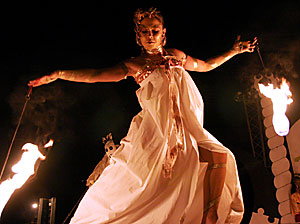 |
|
MATTHEW ROBLES/Arizona Daily Wildcat
|
One of the many fire dancers at the All Souls' Procession performs at the parade's finale yesterday evening. Thousands crowded downtown streets to watch and participate in the unique cultural event.
|
|
|
By Lisa Rich
Arizona Daily Wildcat
Monday, November 8, 2004
Print this
Dressed in brightly colored costumes and wearing black and white face paint, Tucson residents paraded downtown in last night's 15th annual All Souls' Procession, a festival meant to celebrate life while honoring the dead.
Beginning at 7:30 p.m. on the corner of North Fourth Avenue and East University Boulevard, more than 4,000 participants and spectators occupied the streets until the parade ended after 9 p.m. at East Toole Avenue and North Stone Avenue, said Officer Mario Portillo of the Tucson Police Department.
Before the event started, Portillo said he expected a large turnout despite the rainy weather because of the procession's growing popularity.
"It's been getting bigger and bigger each year," Portillo said. "It's not just thousands of people on the street, but also hundreds of participants."
Thriving on the spirit of the Mexican holiday Día de los Muertos, or Day of the Dead, the procession combines cultural rituals with personal exploration as a way to remember the dead while celebrating the living, according to the All Souls' Procession Web site.
Although Día de los Muertos is traditionally celebrated Oct. 31 to Nov. 2, the ASP Web site said the event was chosen for this weekend to avoid confusion with Halloween.
Some participants dressed in black, carrying pictures of deceased loved ones above their heads while burning sage, an herb thought to bless those who inhale its smoke.
Other participants pulled homemade floats covered in flowers, wreaths and incense while chanting to the sound of bongo drums, flutes, maracas and tambourines.
Many residents feel since the procession began in 1990, it has since become an important aspect of Tucson's cultural life in relation to Mexican traditions.
"We need to remember how close we are to Mexico. We're not only neighbors but cultural friends," said Jessica Alandia, a Tucson resident and 1990 UA graduate.
Alandia, dressed in a red Spanish flamenco gown, wore a large white papier-mâché mask designed as a skull.
"The festival celebrates life, death and the courage to live," Alandia said.
Alandia, who has participated in the parade for three years, said it is her way of celebrating the multicultural bond between Mexico and the United States.
John Willman, a Tucson resident and Tucson Puppeteers employee, said the festival is a cultural part of Tucson that residents would never see in other Arizona cities such as Phoenix.
"It's quintessential to the indigenous people of Tucson," Willman said. "It's our way of honoring the dead while having a good time celebrating life."
Willman said there is no single sponsor or leader of the procession, and it has developed into a grassroots project among the community.
The event relies primarily on local businesses and artists, who work together in donating the time, skill and money needed for the parade. The Tucson Puppeteers donated their "sweat equity" in the making of floats and papier-mâché puppets, Willman said.
In addition to the cultural aspect of the parade, the festival attracted some people who were intrigued by the loud music, belly dancing and men walking on stilts. Some said they were surprised to see a strong political opinion among the participants.
"It's a culturally different experience, but it's also political," said Kimi Camozzi, finance sophomore.
Camozzi said she had no idea what to expect when she first came to the festival, and was surprised to see the statue of liberty in a coffin and a walking dead Uncle Sam.
Tucson residents Peter McCallum and his wife, Aisling, said the festival allowed them to express how a small part of the country has died since last week's election.
With painted black faces, the couple wore tombstones reading "R.I.P." with words like "liberty" and "freedom of speech" listed below.
Despite their political expression, the McCallum's both said the festival showed a side of Tucson culture that is not expressed enough.
Beginning in 1990, the procession started when local artist Susan Johnson performed a ritualistic dance for the community, in the spirit of Día de los Muertos to honor her deceased father, according to the ASP Web site.
Since then, the Web site said the project was adopted and expanded by local artists and businesses who wanted to provide a cost-free event, reconnecting Tucson with its cultural identity.
